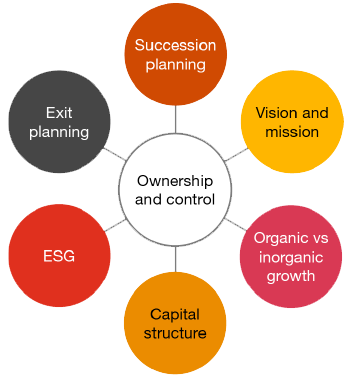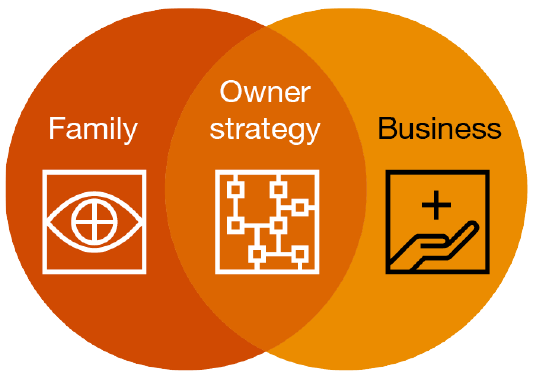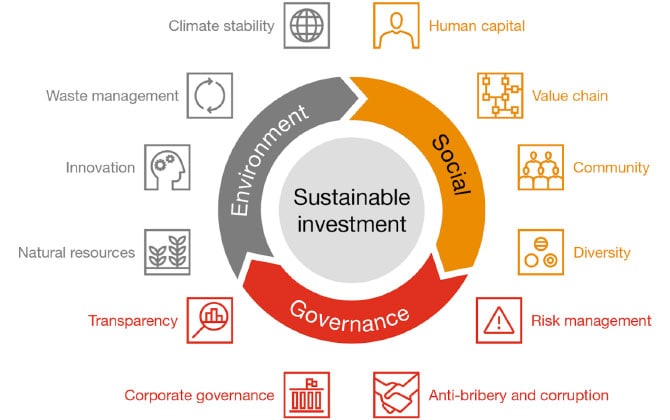The substantial and rapid changes in the world affect all sectors and cause great uncertainty. Family business owners are challenged to stay ahead of the curve by remaining relevant and competitive. Family businesses however are unique, in that they often require balancing the needs of the business with that of the families’ objectives and expectations.

This additional layer of complexity can sometimes “muddy the water” for family business managers, slowing down decision-making and even resulting in inaction and missed opportunities.
Strategically, one could preemptively address this potential negative consequence by being proactive in defining, and then aligning family and business objectives, setting out a clear strategic framework as a reference for family business leaders tasked with executive decision-making.
Typically, such a framework should be designed to assist owners in developing both ownership and business strategies in a consistent and integrated way, within a family context.
Family owners should have an ownership strategy in place encompassing the following:
- professionalising the members of the family business;
- creating an experience for the improvement of family dynamics; and
- developing a family constitution.
The objective of the ownership strategy is to ensure a sustainable future for both family and business.
Other high-impact considerations applicable to the family business are summarised in the following diagram:

Family business owners should consider the impact of these aspects on their business success.
Succession planning
The process of transitioning the management and ownership of a family business to the next generation (NextGen) involves ensuring that the correct decisions are made timeously to prevent disruption to the operations of the business or the eventual destruction of value due to a leadership vacuum. Business owners must undertake this daunting and sensitive process themselves.
Whether the intention is to pass the business on to the NextGen family members, to a professional management team not necessarily family related, or to sell externally, a well-documented plan for the succession is of high importance.
Naturally, family business owners would often like to keep the business within the family, but this may not always be the best option for all involved. Some factors that need to be considered prior to making this decision include:
Are there family members already involved in the business that can ensure a smooth transition?
Business owners may pass the business on to NextGen family members who don’t have the necessary interest or expertise to run the business.
More than one NextGen family member might be interested in leading the business, which may create conflict within the family.
If the intention is to pass the business on to the NextGen of family members, who may not have the full breadth of experience to run the business, family business owners could consider getting a sophisticated strategic investor on board as a co-shareholder, who will work with existing shareholders as well as the management team to provide guidance in managing the business.
Private equity firms or other investment holding companies with sector expertise may be ideal in this scenario, as they generally do not have the interest or intention to assume full operational control of the company but do have skilled and experienced boards and executives. They are willing to work with management, providing guidance, strategic insight, and have valuable networks to further the business’s objectives. In such an instance, selecting the best investment partner and aligning interests of the co-shareholders when negotiating the deal is a key precursor to achieving a successful outcome over the long run.
Ensuring that there is a common view of values between the family and the new co-investor is another important factor to consider prior to entering such a partnership. This option would also provide the family with a partial exit of capital which could be used to diversify the family’s wealth and investments.
Selling the family business externally is another option if no family successor is available. Exiting a majority interest to a trade buyer is generally the optimal method of realising maximum value given the potential synergies and market benefits a trade buyer could achieve as opposed to a private equity investor acquiring a minority interest. However, some private equity buyers have been competitive against trade buyers, especially when there is a capable management team willing and able to take charge of the business, which the private equity firm could back and partner with. If the owner has succeeded in creating a sustainable business model with an ongoing positive growth trajectory, the business will naturally generate interest from both trade and financial buyers.

Ownership and control
Family businesses should regularly assess their ownership strategy from a business perspective, but also with reference to the changing circumstances of the family.

Conflict between family members regarding the leadership or ownership of a family business can be detrimental to the family and the business itself.
For example, a world-famous clothing brand business, owned by an internationally reputable family, was sold to external investors due to conflict between second and third-generation family members regarding the company's leadership.
In another case of an iconic luxury fashion brand business, the founding family lost the company because of the NextGen’s inability to collaborate and align interests in a constructive way. Family infighting ultimately led to significant value destruction and loss of control over the business.
The good news is that if the family is proactive in their approach towards minimising conflict and complexity, it will lay a foundation for long-lasting business success.
The family needs to have clarity on how the ownership of the business will be regulated in the long-term. If the business is in its first generation, the family members involved may find it quite simple to run the company. However, once the business reaches its third and fourth generations, a situation may arise where there may be too many family members with divergent objectives involved in the business. Some family members may want control of the business and others may want to exit the business. These potential scenarios need to be carefully managed to ensure that the long-term success of the business is not compromised.
Shareholders who obtained their business holding due to inheritance may not be interested in participating going forward. Such a scenario would need to be dealt with rationally and swiftly as it could impact capital allocation decisions and the business’ ability to fund new and ambitious projects.
Possible exits for an existing family member could therefore be to sell to an existing family shareholder (of which price is always a sensitive issue) or allow the company buy-back of the family members’ shares. If this fails, the option of teaming up with a strategic investor may be an alternative means to sell the shares.
Vision and mission
The vision and mission of the business need to align with that of the family owners and their values. Conversely, it is also important to ensure that family members who want to be involved in the business are also aligned with such potentially inherited values. These values in some cases have even been constitutionally governed as necessary requirements for a family member to participate in the business.
According to the Africa Family Business Survey 2023, 44% of African family businesses have a documented vision and purpose, or mission statement, for their company. A family business without a common purpose and vision may find it difficult to navigate the serious challenges facing the business in the long term.
Inextricably linked to a company’s vision, is its values. The values of the business are its building blocks and are embedded in its corporate culture. The values of the company and the family should intersect with the intention of guiding the behaviour of all stakeholders involved.
Organic vs inorganic growth
Inevitably, occasional "game-changing” opportunities may arise, such as the potential sale of a competitor business, new fast-growing markets in other regions, or ancillary products with a natural fit to that of the business. However daunting it may be, mergers and acquisitions (M&A) remain a strategic business option for family business owners who may want to take advantage of the aforementioned opportunities.
Family businesses may pursue an M&A strategy for some of the following reasons:
acquisitions of competitors that complement the existing business and serve to gain market-share;
geographical expansion into fast-growing regions for the business’s products;
vertical integration of the value chain i.e., securing more profit margins;
diversification of products or services; and
a means to achieve greater liquidity of holdings, for example, a reverse takeover of a smaller publicly listed company.
To fund these acquisitions, different types of capital raising options are available to owners explained further under Capital structure.
Capital structure
An optimal capital structure serves investors by funding a business in the most cost-efficient manner without placing its cash flows under pressure.
Capital sources come in different forms:
Equity: At-risk capital held in the business by its owners, giving them ownership rights as well as a proportional share in business profits. Equity generally has the highest cost of capital given the level of risk being taken and consequently being last in line to receive capital back should the business fail. Therefore, an equity investor’s required rate of return will be higher than that of debt issuers.
Debt: These are borrowed funds that a business raises from a lender with a commitment to repay according to agreed terms. The cost of debt would depend on the market of issuers and the relative ability of the business profits to cover its finance costs.
Hybrid instruments: This funding method combines the characteristics of both debt and equity. Common examples of hybrid instruments are preference shares or convertible bonds which start off as a common bond but have the potential to convert into equity, depending on the performance of the business. The cost of these instruments will be somewhere between that of equity and debt and will be negotiated between the issuer and the business.
Another effective source of funding could be to reorganise the balance sheet and reconsider which “capital heavy" assets should be carried by the business. For example, sale and leaseback arrangements whereby a business can look to sell a property asset and then immediately lease the asset back over a long-term period, with the right of first refusal. The capital released could then be redeployed towards projects with higher returns or paid back to shareholders who can invest such capital more effectively elsewhere.
It is likely that a business could use multiple sources of funding to achieve the most optimal capital structure considering each business’s unique characteristics and requirements.
Environmental, social, and governance (ESG) concerns
Family businesses are intrinsically linked to the community in which they operate, and therefore it is beneficial to consider the impact of the business on various stakeholders in the wider economy. Family businesses, which are often driven by their values, have the unique opportunity to create a meaningful impact on society and take the lead on ESG. As this is an emerging topic, many family business owners have been considering ESG and how it should be embedded in their business. In addition, family businesses need to become more transparent about their contribution to ESG, as this builds trust in society, and sets them apart from their competitors.
Whilst most companies are committing more capital towards more sustainable projects such as renewable energy, decarbonisation, waste management, and better water usage, other aspects should also be considered, such as board diversity, executive compensation, and anti-corruption measures.

Impact investment could be another ESG strategy by investing in commercial enterprises or projects that have good financial returns, but with high societal impact. Family businesses should consider investing in a way that not only preserves wealth for future generations but also building its reputation and a legacy for the future.
Exit planning
In time, the family may wish to exit the business for many different reasons. It is important to be cognisant of this possibility and plan such an exit well in advance should the sale become a reality.
Family business owners should consider several important factors:
They need to determine their financial and personal objectives for the exit, which may include maximising the value of the business and preparing for a smooth ownership transition and preserving harmony in the family.
The business should be prepared for the transition by ensuring that an established and capable leadership team that can take the business forward without family business owners being involved, ensuring that best practice governance and management structures are in place and all legal and financial matters are in order.
The owners should consider the potential tax consequences of such an exit and obtain professional advice to ensure that such a transaction would be executed in the most efficient manner.
The family owners should consider the valuation terms, including the method of payment or financing and pay-off period, if necessary, in the event of buying out other family members.
They seek professional advice on identifying value creation opportunities, and then rapidly implementing simple and effective value levers identified prior to exit, which would support the achievement of a premium on the exit value.
Family businesses need to adapt and innovate to remain competitive and relevant. However, they must also balance these demands with the unique challenges of managing family objectives, succession planning, and aligning with family values.
Effective leadership of a family business requires a delicate balance of these competing demands, as well as a strong understanding of the unique dynamics that come with managing a family enterprise.
By embracing these challenges and leveraging the strengths of both the business and the family, family business leaders can successfully navigate the complexities of leading in a rapidly changing world, while preserving the legacy and values of the family enterprise.
Contact us


















